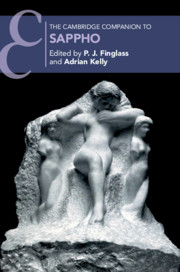Book contents
- The Cambridge Companion to Sappho
- Cambridge Companions to Literature
- The Cambridge Companion to Sappho
- Copyright page
- Contents
- Plates
- Contributors
- Abbreviations
- Introduction
- Part I Contexts
- Part II Poetics
- Part III Transmission
- Part IV Receptions
- Bibliography
- General Index
- Index to the Reception of Sappho
- Plate Section
- References
Part III - Transmission
Published online by Cambridge University Press: 09 April 2021
- The Cambridge Companion to Sappho
- Cambridge Companions to Literature
- The Cambridge Companion to Sappho
- Copyright page
- Contents
- Plates
- Contributors
- Abbreviations
- Introduction
- Part I Contexts
- Part II Poetics
- Part III Transmission
- Part IV Receptions
- Bibliography
- General Index
- Index to the Reception of Sappho
- Plate Section
- References
Summary

- Type
- Chapter
- Information
- The Cambridge Companion to Sappho , pp. 217 - 260Publisher: Cambridge University PressPrint publication year: 2021
References
Further Reading
The most up-to-date treatment of Sappho’s Alexandrian edition remains Liberman 2007. For new insights provided by the ‘Newest Sappho’ into the articulation of Book 1, see Obbink 2016b, D’Alessio 2019. For the vexed issue of Sappho’s Epithalamia, the most recent contributions are Yatromanolakis 1999, Puglia 2008, and Dale 2011a. For the early reception, textual and visual, of Sappho in the fifth and fourth centuries, see Yatromanolakis 2007 and Coo. For the direct and indirect transmission of Aeolic poetry, see Nicosia 1976.
Further Reading
Janko 2005 (on the New Sappho) and Obbink 2014b (on the Newest Sappho) offer approachable guides to newly discovered papyri. The major problems with the provenance of the latter papyri are treated by Mazza 2019 and Sampson 2020; this is a fast-moving area which has attracted considerable international press attention. An outstanding account of the discovery of papyri from the nineteenth century onwards is provided by Parsons 2007.
Further Reading
DeJean 1989a remains central to this topic, as does Most 1995 ≈ Greene 1996b: 11–35; both demonstrate how philological problems and the interpretation of Sappho’s life and poetry are intertwined.

